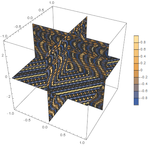Difference between revisions of "SOCR News APS Dinov Spacekime March 2022"
(→Session Logistics) |
|||
| (3 intermediate revisions by the same user not shown) | |||
| Line 1: | Line 1: | ||
| − | == [[SOCR_News | SOCR News & Events]]: Data Science, | + | == [[SOCR_News | SOCR News & Events]]: ''Quantum Physics Interface to Data Science, Artificial Intelligence, and Spacekime Analytics'' == |
[[Image:Spacekime_TCIU_Trivial_PolarCylinder_WaveEqu_Phase.png|150px|thumbnail|right| [https://www.socr.umich.edu/TCIU/ Spacekime/TCIU Project] ]] | [[Image:Spacekime_TCIU_Trivial_PolarCylinder_WaveEqu_Phase.png|150px|thumbnail|right| [https://www.socr.umich.edu/TCIU/ Spacekime/TCIU Project] ]] | ||
| Line 15: | Line 15: | ||
* '''Conference''': [https://march.aps.org/ March 2022 APS Meeting] | * '''Conference''': [https://march.aps.org/ March 2022 APS Meeting] | ||
* '''Session''': [https://meetings.aps.org/Meeting/MAR22/Session/W66 Session W66 (Frontiers in Fundamental Physics II)] | * '''Session''': [https://meetings.aps.org/Meeting/MAR22/Session/W66 Session W66 (Frontiers in Fundamental Physics II)] | ||
| − | * '''Zoom''': | + | * '''Zoom''': [https://apsmarch22.onlineeventpro.freeman.com/sessions/23878726/W66 Freeman Online Event Link] |
* '''Talk Format''': Online virtual presentation; specific time: 3:48 PM–4:00 PM CT | * '''Talk Format''': Online virtual presentation; specific time: 3:48 PM–4:00 PM CT | ||
* [https://wiki.socr.umich.edu/index.php/SOCR_News_APS_Dinov_Spacekime_March_2022 This URL] | * [https://wiki.socr.umich.edu/index.php/SOCR_News_APS_Dinov_Spacekime_March_2022 This URL] | ||
| Line 27: | Line 27: | ||
| − | '''Slidedeck''': [https://socr.umich.edu/docs/uploads/2022/ | + | '''Slidedeck''': [https://socr.umich.edu/docs/uploads/2022/Dinov_Spacekime_APS_Session_W66.5_2022.pdf PDF Slides]. |
==Background== | ==Background== | ||
| Line 41: | Line 41: | ||
==References== | ==References== | ||
* Dinov, ID and Velev, MV (2022) [https://doi.org/10.1515/9783110697827 Data Science: Time Complexity, Inferential Uncertainty, and Spacekime Analytics], De Gruyter (STEM Series), Berlin/Boston, ISBN 9783110697803 / 3110697807, DOI 10.1515/9783110697827. | * Dinov, ID and Velev, MV (2022) [https://doi.org/10.1515/9783110697827 Data Science: Time Complexity, Inferential Uncertainty, and Spacekime Analytics], De Gruyter (STEM Series), Berlin/Boston, ISBN 9783110697803 / 3110697807, DOI 10.1515/9783110697827. | ||
| + | * Wang, Y, Shen Y, Deng, D, Dinov, ID. (2022) [https://doi.org/10.1016/j.padiff.2022.100280 Determinism, Well-posedness, and Applications of the Ultrahyperbolic Wave Equation in Spacekime], Journal of Partial Differential Equations in Applied Mathematics, DOI: 10.1016/j.padiff.2022.100280, in press. | ||
| + | * Zhang, R, Zhang, Y, Liu, Y, Guo, Y, Shen, Y, Deng, D, Qiu, Y, Dinov, ID. (2022) [https://doi.org/10.1007/s00521-021-06789-8 Kimesurface Representation and Tensor Linear Modeling of Longitudinal Data], Neural Computing and Applications Journal, DOI: 10.1007/s00521-021-06789-8. | ||
* [https://www.socr.umich.edu/spacekime/ Spacekime website] | * [https://www.socr.umich.edu/spacekime/ Spacekime website] | ||
* [https://tciu.predictive.space/ Time-Complexity and Inferential Uncertainty (TCIU)] | * [https://tciu.predictive.space/ Time-Complexity and Inferential Uncertainty (TCIU)] | ||
Latest revision as of 07:28, 17 March 2022
Contents
SOCR News & Events: Quantum Physics Interface to Data Science, Artificial Intelligence, and Spacekime Analytics
Presenter
- Dr. Dinov is a professor of Health Behavior and Biological Sciences and Computational Medicine and Bioinformatics at the University of Michigan. He is a member of the Michigan Center for Applied and Interdisciplinary Mathematics (MCAIM) and a core member of the University of Michigan Comprehensive Cancer Center. Dr. Dinov serves as Director of the Statistics Online Computational Resource, Co-Director of the multi-institutional Probability Distributome Project, and Associate Director of the Michigan Institute for Data Science (MIDAS). He is a member of the American Statistical Association (ASA), International Association for Statistical Education (IASE), American Mathematical Society (AMS), American Association for the Advancement of Science (AAAS), American Physical Society (APS), and an Elected Member of the International Statistical Institute (ISI).
Session Logistics
- Date/Time: Thursday, March 17, 2022, 3:00 PM – 5:36 PM, US Central Time, (UTC-6)
- Talk Title: Quantum Physics Interface to Data Science, Artificial Intelligence, and Spacekime Analytics
- Registration: Registration Link
- URL: APS session W66 meeting website
- Conference: March 2022 APS Meeting
- Session: Session W66 (Frontiers in Fundamental Physics II)
- Zoom: Freeman Online Event Link
- Talk Format: Online virtual presentation; specific time: 3:48 PM–4:00 PM CT
- This URL
Abstract
Physics is in the core of many data-intensive research activities; from governing molecular interactions, to modeling social behavior networks, enabling solid-state data storage, facilitating Ising modeling of numerical simulations, and underpinning Metropolis–Hastings estimation and optimization in machine learning (ML) and artificial intelligence (AI) applications. This talk will present a direct connection between quantum mechanical principles, data science foundations, and statistical inference on longitudinal processes.
By extending the physical concepts of time, events, particles, and wavefunctions to their AI counterparts – complex-time (kime), complex-events (kevents), data, and inference-functions – spacekime analytics provides a new foundation for representation, modeling, analyzing, and interpreting dynamic high-dimensional data. We will show the effects of kime-magnitude (longitudinal time order) and kime-direction (phase) on AI predictive analytics, forecasting, regression, classification, and scientific inference.
The mathematical foundation of spacekime analytics also provide mechanisms to introduce spacekime calculus, expand Heisenberg’s uncertainty principle to reveal statistical implications of inferential uncertainty, and a develop a Bayesian formulation of spacekime inference. Lifting the dimension of time opens a number of challenging theoretical, experimental, and computational data science problems. It leads to a new representation of commonly observed processes from the classical 4D Minkowski spacetime to a 5D spacekime manifold. Using simulated data and clinical observations (e.g., structural and functional MRI), we will demonstrate alternative strategies to transform time-varying processes (time-series) to kime-surfaces and show examples of spacekime analytics.
Slidedeck: PDF Slides.
Background
- SOCR News & Events
- SOCR Global Users
- SOCR Navigators
- SOCR Datasets and Challenging Case-studies
- Electronic Textbooks:
References
- Dinov, ID and Velev, MV (2022) Data Science: Time Complexity, Inferential Uncertainty, and Spacekime Analytics, De Gruyter (STEM Series), Berlin/Boston, ISBN 9783110697803 / 3110697807, DOI 10.1515/9783110697827.
- Wang, Y, Shen Y, Deng, D, Dinov, ID. (2022) Determinism, Well-posedness, and Applications of the Ultrahyperbolic Wave Equation in Spacekime, Journal of Partial Differential Equations in Applied Mathematics, DOI: 10.1016/j.padiff.2022.100280, in press.
- Zhang, R, Zhang, Y, Liu, Y, Guo, Y, Shen, Y, Deng, D, Qiu, Y, Dinov, ID. (2022) Kimesurface Representation and Tensor Linear Modeling of Longitudinal Data, Neural Computing and Applications Journal, DOI: 10.1007/s00521-021-06789-8.
- Spacekime website
- Time-Complexity and Inferential Uncertainty (TCIU)
Translate this page:
